HIIT Conditioning – What You Need To Know
Introduction
You have probably been struggling with finding a one-stop-shop guide on HIT conditioning for your athletes. I know I have. For this reason, I have decided to create a simple, no BS book, which you can easily reference and quickly come up with HIIT running drills, without unnecessary scientific fuss. Something that is pragmatic as hell.
HIT stands for High Intensity Training, and as any other training construct, it is hard to be precisely defined. I want this book to be more actionable and less precise, or to satisfice, as Herbert A. Simon, father of artificial intelligence, would call it. In other words, I want the approach to HIT in this article series to be good enough, so it can be easily applied in practical settings and understandable by coaches. Having said this, I consider all training intensities above velocity at lactate threshold (vLT), or velocity at gas exchange threshold (vGET) to be High-Intensity Training.
I am pretty certain that some lab coats will complain and point to the facts that the numbers in this book are not precise, or that the planning strategies outlined are not optimal. These are all fair critiques, but most lab coats reason from unbounded position, where they try to find idealistic or optimal training (conditional on the model assumptions). It bears mentioning a Yogi Berra’s saying: “In theory, there is no difference between theory and practice. In practice there is.” In real life, coaches are struggling with a lot of uncertainties (out of which a few will be covered in this article series), time pressures and constraints, equipment and very weird and unpredictable complex beings called athletes, so finding the ‘optimal’ solution is most likely a waste of time, or even worse, impossible. Hence, in practical and complex settings, such as real-life coaching and training, it is futile to try to find the optimal solution, but rather utilize a few simple rules of thumb (or heuristics) that will help in finding the solution that satisfice. That is exactly my aim with this HIT book.
Tools you will need
To apply the approach presented in this HIT article series, you will need a few basic tools or equipment. Some will be easier to acquire, some will be more costly, and for that reason, I will provide a few alternatives. But, by providing multiple alternatives, I run the risk of making this book more complex and hence less understandable. I do want to make HIT prescription as simple as possible, but not that it becomes too rigid. So, in a way I had to satisfice, and provide something that is precise enough, but also flexible enough for coaches in different situations to apply.
Cones
You would need a simple set of cons to set up the running tracks. Having them in multiple colors (or sizes) might be helpful in distinguishing different groups.
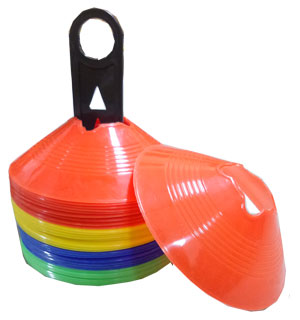
Stopwatch and a Whistle
Hopefully, as a coach, you should already have a stopwatch and a whistle. If you don’t, make sure to get them ASAP and make sure to get a stopwatch with a timer function. Having a timer function helps you time the intervals, especially the short intervals such as 15:15. Use a whistle so that you can give ‘beeps’ to athletes, or yell out the time left, for example: “to the cone in 3… 2… 1… stop!”.
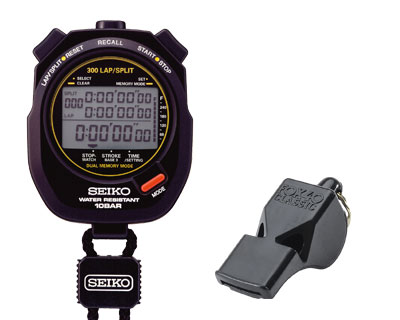
Distance Measuring Wheel
Having a distance measuring wheel is a must. Since you will be estimating distances to be covered in a given time frame, you will be needing a tool that allows you to do that.
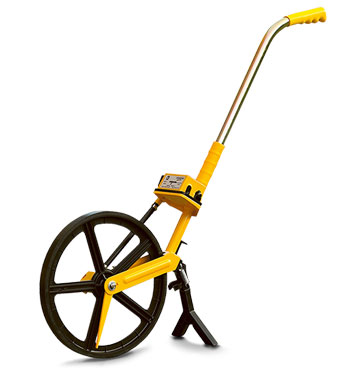
Beeper
In the case where you do not want to look at your stopwatch and give ‘beeps’ using whistle, you can use an outdoor timer with a loud beeper. It does need to be loud. It is also great for playing pranks on your fellow coaches when in the office.
Timing Gates
With some HIT drills, in order to improve prescription precision (and hence individualize better), it is important to know athletes’ MSS (Maximum Sprinting Speed). I will provide a few alternatives on how to assess MSS, but ideally you would want to have proper timing gates.

Shuttle Run Beep Test
It is best to use this article series with the special version of 20m Shuttle Run Beep Test (SRBT), that implements beep corrections for changes of direction (COD). This way, the results from the 20m shuttle version beep test are in higher agreement with straight line beep tests (VamEval, Leger-Bucher or UMTT), while also being training-specific and sport-specific. You will use reached velocity of this test as an estimate of the MAS (Maximum Aerobic Speed).
To perform this test, you will need a loud stereo system and a MP3 player. Your smart phone or tablet connected to a speaker system will suffice. You will find the accompanying collecting sheet and instructions later in this book.
I will also provide a few alternatives to this test, but stating this right up front, Yoyo Intermittent tests are not good substitutes for SRBT.

Buchheit’s 30:15 Intermittent Field Test (IFT)
Buchheit’s IFT is a great alternative and/or addition to SRBT, which also takes into account multiple other qualities (such as MSS, COD efficiency, intra-set recovery and so forth) that makes it outstanding testing choice. Deciding between MSS, MAS and IFT for prescribing HIT drills is an important discussion that will soon be covered. IF you wish to perform Buchheit’s IFT, it can be downloaded HERE: https://3015ift.wordpress.com/2013/07/10/audio-files/
HIT Builder
HIT Builder is accompanying spreadsheet that comes with this article series. It allows quick HIT drills creation for up to 200 athletes. The HIT Builder will be referenced on multiple occasions in this article series. Find out more about this product on the following page.
The bare bones minimum of the tools you will need is the following:
- Cones
- Stopwatch and whistle
- Distance measuring wheel
- Shuttle Run Beep Test (and speaker system)
Velocity Profile
Velocity Profile is a simple and neat way to visualize and understand relationships between the crucial constructs (or qualities) that we are going to use to prescribe HIT.
Let’s assume that Athlete A has MAS of 4.44 m/s (16 km/h) and MSS of 9 m/s (32.4 km/h). Don’t worry, I will explain what MAS and MSS mean.

The Velocity Profile is a simple table that enlists velocities from zero to MSS (Maximum Sprinting Speed). MSS is a maximal velocity that a given athlete can achieve.
MAS stands for Maximum Aerobic Speed and from a physiological standpoint it represents a minimal velocity associated with VO2peak in a GXT (Graded Exercise Test). From a practical standpoint, it represents a velocity (or pace) that athletes can maintain for 5-6 minutes, give or take. Lab coats can argue on these topics till the cows come home, but as coaches, we need something satisficing to work from, something that is good enough to prescribe training, evaluate training effects and also cover our own assessment when the head coach asks us what we have been doing.
There are multiple ways to estimate MAS, and there is no reason for sleepless nights over the correct, the most precise or optimal method to establish it.
Approach I am advocating in this article series will use SRBT to establish MAS. Perfect? No. Usable? You bet.
The Velocity Profile revolves around MSS and MAS. The velocity zone between these two is called ASR, or Anaerobic Speed Reserve and it is important concept for prescribing HIT drills.
Please, don’t bother with distinctions between aerobic and anaerobic in MAS and ASR. Just use the acronyms and look at them as satisficing constructs useful for prescribing HIT.
The great research by Bundle, Weyand et al. (see References at the end of this book) confirmed that certain % of ASR can be maintained for certain limited time (Tlim on the table) REGARDLESS of MAS and MSS.
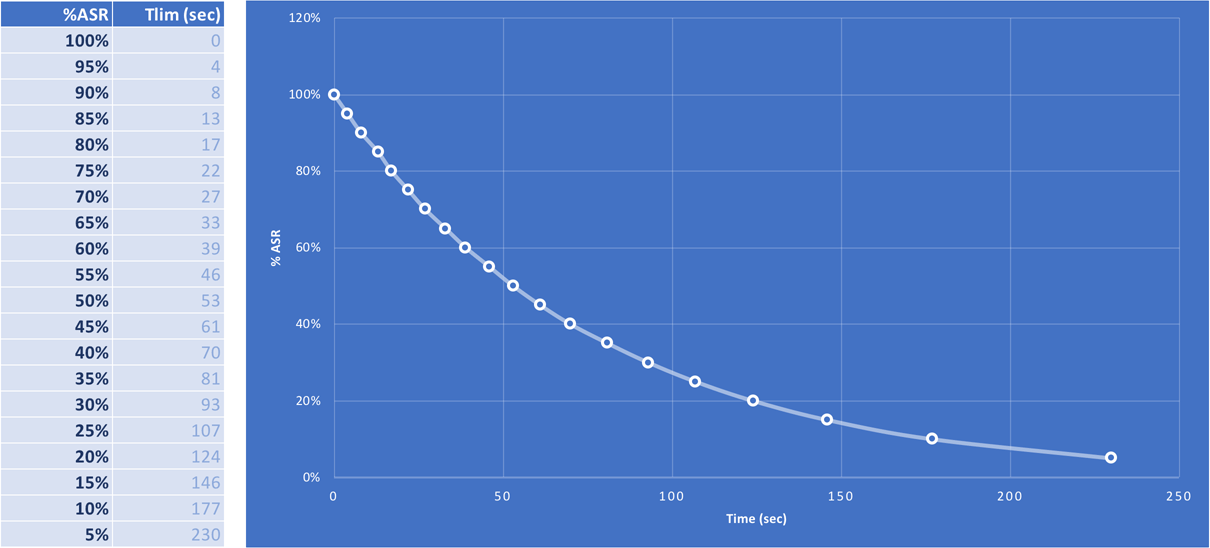
This has multiple practical applications. First, if we know MAS and MSS, we can predict, with certain level of precision, performance on a certain distance. For example, our Athlete A with MSS of 9 m/s (32.4 km/h) and MAS of 4.44 m/s (16 km/h) can maintain 90% of his ASR velocity (8.54 m/s) for 8 seconds, during which he will cover around 70 meters. If we wish to predict his 100m time, we can do that as well – it is 12 seconds and it represents 85% of his ASR.
Second, if we know two time trials (e.g. 100m and 400m), we can establish MAS and MSS. Let’s assume that Athlete B covers 100m in 12 seconds, and 400m in 60 seconds. Using the above model, his MSS is estimated to be 8.94 m/s (32.2 km/h) and his MAS to 4.74 m/s (17.1 km/h). There are more nuances here, of course, like time loss on the start that needs to be take into account, but the relationship still holds.
Third, we might estimate MSS from known MAS and one time trial (or vice versa – establish MAS from known MSS and one time trial). Let’s assume that Athlete C has MAS of 4 m/s (14.4 km/h) established using SRBT, and runs 100m in 10.5 seconds. The established MSS is 10.33 m/s (37.2 km/h).
Fourth, assuming that MSS and MAS are causal constructs/qualities that explain (and cause) HIT performance (let’s not forget that they are actually estimated from performance itself) we can perform sensitivity analysis. In plain English, for a given distance of interest (e.g. 400m) and for a given athlete with his MAS and MSS values, we can check which variable improvement (either MAS or MSS) will yield more improvement in times for that distance. This can help inform training interventions (i.e. focus more on improving MSS or MAS). This is quite usable to T&F coaches, especially middle-distance.
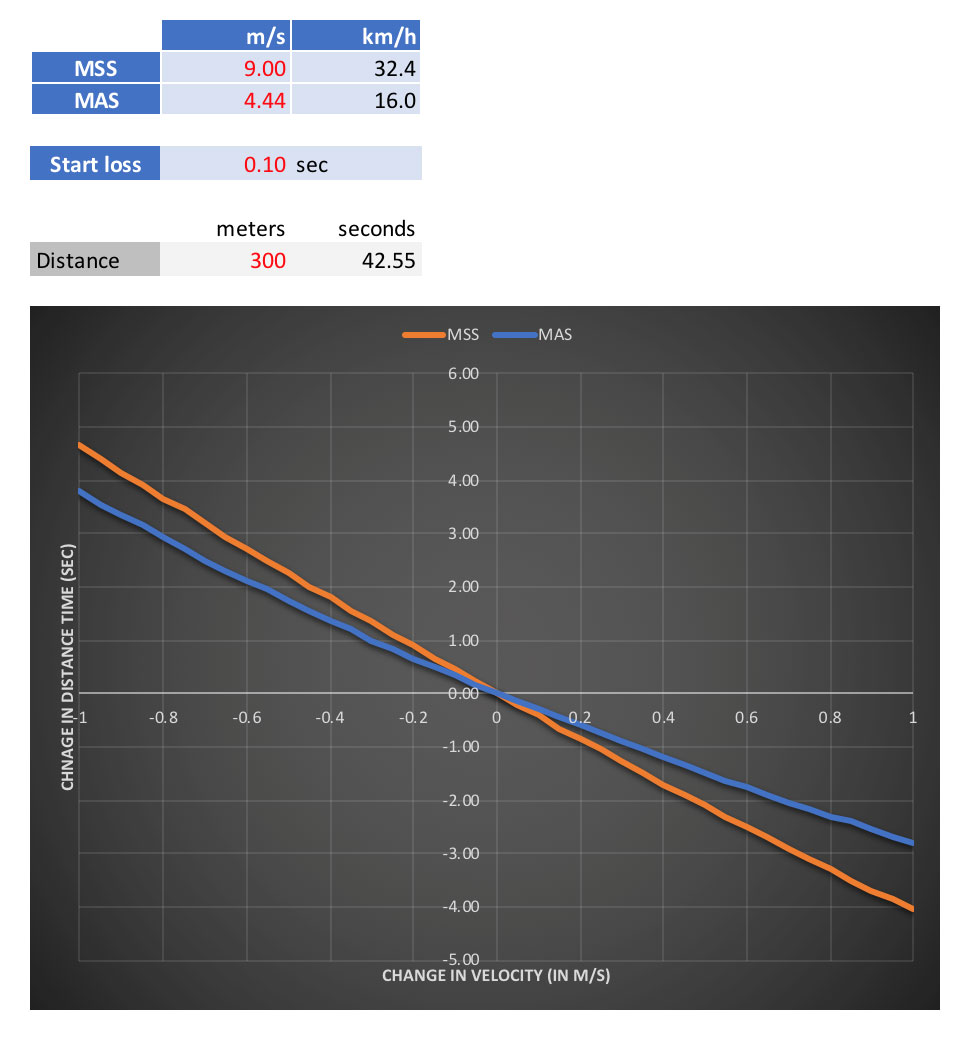
All of these functionalities are available in the accompanying HIT Builder. For those mathematically inclined, the above relationships are expressed as:

For running the coefficient k is equal to 0.013 and for cycling it is 0.026.
This model is very useful for velocities above MAS and for all-out sprints of less than 150 seconds in duration. This brings me to one important aspect – the need to use multiple models, since none of the performance models can be useful (and predictable) across the whole Velocity Profile. For example, knowing individual vGET (velocity at gas exchange threshold), or second ventilator threshold (vVT2), as well as velocity at first ventilator threshold (vVT1), is very helpful in predicting performance and prescribing training for time durations over 20 minutes, or in other words, for long distance runners. But, since this is a HIT book (i.e. for training at intensities over vGET or vLT2) I won’t be expanding on these topics (although you can check references, especially from Seiler et al.). All that I will mention for the sake of big picture is that vGET is around 80% of MAS or 90% of HRmax.
Everything we need to know to prescribe HIT are MAS and MSS. One can use solely MAS, but ideally MAS is satisficing for prescribing HIT from cca. 90% till 105% MAS. For HIT above 105-110% MAS, it is better to use ASR (Anaerobic Speed Reserve). Buchheit’s IFT test, whose reached velocities are around 1.15 to 1.20 times bigger than MAS (e.g. someone with 4 m/s MAS will most likely reach 4.6 m/s in IFT), is great for prescribing 105-120% MAS (or 85-105% IFT) HIT drills. In plain English, although great alternative and very usable for prescribing short intervals (less than 1min in duration), IFT is not enough for full scale of HIT prescriptions. If you plan doing solely short intervals, then it is absolutely great choice that can replace using MAS and MSS completely, but if you plan prescribing long intervals (>1min), or very high intensity runs (>130-140% MAS), then you will need MAS and MSS estimates. Either way, I will provide %IFT associated with different HIT drills, in case you opt for that approach.
What about heart rate, you might ask? Completely useless in HIT prescription. What about using heart rate recovery to prescribe the next start of the interval (e.g. wait until HR drops to 130bpm or 60% HRmax)? Useless as well, especially when working with large groups. Like I am going to let 30 soccer athletes decide when to start the next interval. In your dreams buddy.
Testing
To prescribe HIT using the approach outlined in this book, you will need estimated MSS and MAS (or IFT). There are, of course, multiple approaches to do that and I will cover a few alternatives. Let’s start with MAS, since having MAS without MSS will still allow you plenty of HIT prescription options.
Estimating Maximum Aerobic Speed (MAS)
As mentioned before, MAS is minimal velocity associated with VO2peak in GXT (graded exercise testing). There are, of course, nuances and arguments between lab coats, regarding the best way to establish MAS, from stage durations to increments in velocity during GXT. Won’t bother you with that. So, do you need laboratory test? Absolutely no.
There are multiple field options you can use and I highly recommend using 20m Shuttle Run Beep Test (SRBT) that is best used with this book. The test is performed between 20m cones until exhaustion. Velocity starts at 10km/h and it is increased by 0.5km/h each minute. The difference between this version of beep test and the original is in COD (change of direction) correction. Let’s assume that athlete performs straight-ahead beep tests, such as UMTT or VamEval, which are performed on the 200-400m track with cones set every 20m and velocity increasing for 0.5km/h every minute. He reaches 16km/h stage. Now, imagine he does this same test in shuttle fashion, where he needs to start and stop and change direction. Will he reach the same 16km/h stage?
The problem with the original shuttle run beep test is that is doesn’t correct the time loss on COD, so MAS estimated using that test will be underestimating true MAS and if you use that MAS for straight ahead HIT conditioning, it will underestimate the intensities needed.
The SRBT which is best used with this book, uses COD corrections, but adding 0.7s per turn. Perfect? No. Satisficing? Definitely. This way, the SRBT estimates of MAS can be used for prescribing HIT for both straight line and shuttle-based conditioning.
To perform this test, you will need 20m lanes for every athlete, MP3 file and a speaker system, as well as the collecting sheet (that can be found at the end of this book). Athletes can perform standardized warm-up and then perform the test. The audio track will state the velocity at the beginning of each stage. For the sake of simplicity, write down latest stage velocity that athlete was able to pass. It is a standard practice to give three warning signs in a row, before athlete is out from the test, but you can change this to any other, just make sure you are following the protocol you defined, every time you perform the test.
Alternatives
Alternatives to SRBT might include time trial or 5 to 6 minutes, or 1200-2000m (depending on the level of the athletes), where MAS is the average velocity (MAS = distance covered / time in seconds). But, in my experience, a team sport athlete struggles with finding the right pacing for these tests. If you have a training group that is experienced with those longer time trials, then be my guest and use this approach.
Another alternative is to use Buchheit’s 30-15IFT and then assume MAS is IFT/1.2 (i.e. if IFT is 5m/s then MAS is 5 / 1.2, or 4.16 m/s). Again, this is not perfect, but it is satisficing to get MAS estimate.
You can also utilize straight ahead tests, such as UMTT or VamEval. In my experience, working with team sport athletes, it would be head coaches and even athletes to complain that this test is not sport-specific. The problem is not if the test is sport-specific, but rather what do you plan using that test for? If you plan performing a lot of straight-ahead HIT conditioning and prescribe using MAS from that test, then it is perfectly training-specific test.
The SRBT test is not as sport-specific as other tests, such as IFT or YOYO, because it doesn’t have a break between the shuttles or stages. But for the HIT training that is aimed for, it is very training-specific.
There is a trade-off between making test more sport-specific and making test more prescriptive (using the test to prescribe training). For example, one might design incremental intermittent soccer dribbling test, which would be very soccer-specific, but due a lot of ‘qualities’ involved in this test, one would be uncertain if the test score is due to higher MAS, better COD, better dribbling technique, faster between-shuttles recovery, or you name it yourself. Then it becomes too complex for HIT conditioning prescription (unless you HIT drills involve dribbling the ball all the time). In a way, there needs to be a balance between sport-specificity of the test and complexity introduced. I find that balance in SRBT and IFT tests.
What about YOYO tests? Can you use the velocity reached in YOYO tests to estimate MAS and then prescribe HIT conditioning. No, you can’t. The problem with YOYO is that the work:rest changes and the velocity increases and that makes connection to MAS more complex. The YOYO tests are great sport-specific tests, but they are not useful if you are planning to use the velocity reached on them to prescribe HIT conditioning. But what if you plug in a distance or speed reached in YOYO, in some regression formula to get MAS? According to the research (see References), there is too big of an estimation error for the MAS established that way to be useful. So, ditch the YOYO tests for that reason (of prescribing HIT conditioning).
If you still plan to do laboratory GXT, then stick to a similar velocities progression, stage durations and around 1% treadmill incline.
Estimating Maximum Sprinting Speed (MSS)
Estimating MSS is a bit trickier, in a way that it demands timing gates. The protocol involves setting the timing gates with 5-10 m distance and allowing 30-60 m flying start for the athletes. It is up to the athletes to decide on the run-up distance as long as they reach best 5-10 m split time. Number of trials is around 5-7, with athletes allowed to take rest as much as they need.

As with other testing, the key is to stick to the same protocol when one repeats the tests.
Alternatives
What would be an alternative to estimating MSS? One alternative would be to use hand timed 40 m time, known MAS and plug it into the ASR formula. Let’s say that our Athlete D has a MAS of 4.5 m/s and runs 40m dash for 4.8 second. We plug this into the HIT Builder and we get the following:











Responses